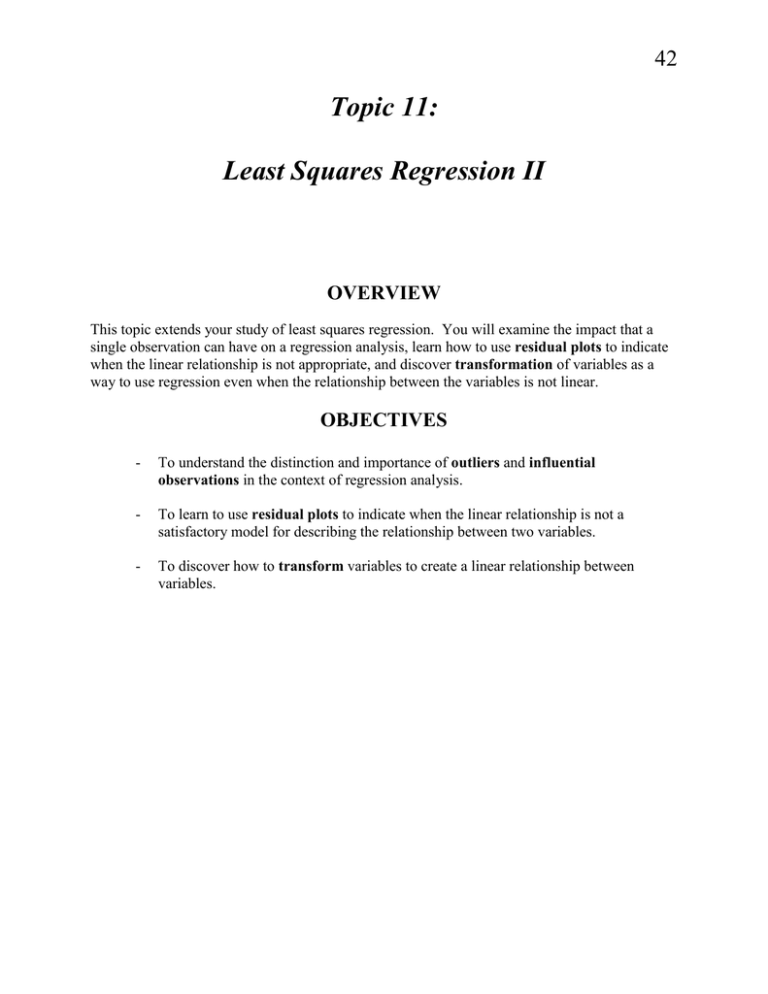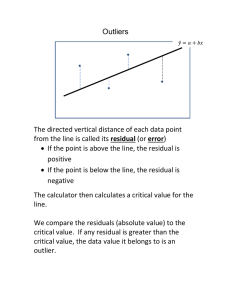Topic 11: Least Squares Regression II 42
advertisement

42 Topic 11: Least Squares Regression II OVERVIEW This topic extends your study of least squares regression. You will examine the impact that a single observation can have on a regression analysis, learn how to use residual plots to indicate when the linear relationship is not appropriate, and discover transformation of variables as a way to use regression even when the relationship between the variables is not linear. OBJECTIVES - To understand the distinction and importance of outliers and influential observations in the context of regression analysis. - To learn to use residual plots to indicate when the linear relationship is not a satisfactory model for describing the relationship between two variables. - To discover how to transform variables to create a linear relationship between variables. 43 Activity 11-1: Gestation and Longevity The following table lists the average gestation period (in days) and longevity (in years) for a sample of animals, as reported in The 1993 World Almanac and Book of Facts. Enter the gestation data in a list called GEST and enter the longevity data in a list called LONG. Insert pg. 240 a) Use your calculator to determine the regression line for predicting an animal’s gestation period from its longevity. Record the equation of the line below and sketch it on the following scatterplot. (Note: On your calculator, enter LinReg LLONG, LGEST, Y1. This will store the regression equation in Y1.) Insert pg. 241 44 b) Use the regression line to compute the fitted value and residual for a baboon. (Note: You can look at the table of values to find the fitted value and residuals are automatically calculated by the calculator and stored in a list called Residuals.) Fitted Value: Residual: c) Interpret the slope coefficient of this regression line. In other words, explain precisely what its value signifies about longevity and gestation period. d) What proportion of the variability in animals’ gestation periods is explained by the regression line? e) On your calculator, create a scatterplot of the animals’ residual values vs. their longevities. Is there any relationship between residuals and longevities? If so, explain in a sentence or two what that signifies about the accuracy of predictions for animals with long vs. short lifetimes. f) Which of the animals is clearly an outlier both in longevity and in gestation period? Circle this animal on the scatterplot and find its residual value. Does it seem to have the largest residual (in absolute value) of any animal? In the context of regression lines, outliers are observations with large (in absolute value) residuals. In other words, outliers fall far from the regression line, not following the pattern of the relationship apparent in the others. While the elephant is an outlier in both longevity and gestation variables, it is not an outlier in the regression context. g) Which animal does have the largest (in absolute value) residual? Is its gestation period longer or shorter than expected for an animal with its longevity? 45 h) Delete the ordered pair for the giraffe (10, 425). Recalculate the regression equation for predicting gestation period from longevity. Record the new equation and value of r2 (the coefficient of determination) below. r2 : Regression equation: i) The following scatterplot displays the original data and both regression lines. Is this new regression line substantially different from the original line? Insert pg. 243 j) Return the giraffe’s values to the analysis. Then, eliminate the elephant’s case (40, 645). Recalculate the regression equation for predicting gestation period from longevity. Record this new equation and value of r2 (the coefficient of determination) below. r2 : Regression equation: k) The scatterplot below displays the original data with the actual regression line and the line found when the elephant had been removed. In which case (giraffe or elephant) did the removal of one animal effect the regression line more? Insert pg. 244 46 In the context of least squares regression, an influential observation is one whose removal would substantially affect the regression line. Observations with extreme values of the predictor variable are potentially influential. Removing the elephant from the analysis has a considerable effect on the least squares line, whereas the removal of the giraffe does not. The elephant is an influential observation due to its exceptionally long lifetime. Activity 11-14: Gestation and Longevity (cont. again) a) Using the original regression equation that you found in Activity 11-1 part a, how long a gestation period does the line predict for an animal with longevity of 20 years? b) For what longevity does the regression line produce a prediction of a 365-day gestation period? c) Use your calculator to determine the regression line for predicting an animal’s longevity from its gestation period. Write the regression equation below. (Note: On your calculator, enter LinReg LGEST, LLONG, Y2. This will store the regression equation in Y2.) d) What longevity does this line predict for an animal with a gestation period of 365 days? e) Explain why your answers to parts b and d are not close to the same. Activity 11-2: Residual Plots Below are four scatterplots with regression lines drawn in: 1. MPG rating vs. weight for sports cars 2. distance from sun vs. position number (Mercury = 1, Venus = 2, etc.) for planets 3. rent vs. price for Monopoly properties 4. airfare vs. distance for selected destinations 47 a) For each of these data sets, a scatterplot of the residuals from the regression line vs. the explanatory or predictor variable is given. Your task is to match up each residual plot with its regression scatterplot. 48 b) Match up the data with the following descriptions of the residual plots: The residuals are randomly scattered. The residuals are largely randomly scattered except for two very large negative residuals. The residuals show a distinct curved pattern. The residuals show a clear linear pattern with three severe outliers. c) Look back at the original scatterplots with the regression lines drawn in. In which two plots do the lines summarize the relationship in the data about as well as possible? In which two plots do the lines fail to capture important aspects of the relationship? Explain. d) Do the scatterplots where the lines summarize the data about as well as possible correspond to the highest values of r2? These examples show that residual plots can indicate when a liner model does not adequately describe the relationship in the data. When a straight line is a reasonable model, the residual plot should reveal a seemingly random scattering of points. When a nonlinear model would fit the data better, the residual plot reveals a pattern of some kind. Note that the value of r2 alone is not sufficient for assessing the fit of the linear model. WRAP-UP This topic has extended your study of least squares regression. You have examined outliers and influential observations, noting the effects that they can have on regression analysis. You have also learned to use residual plots to judge whether a nonlinear model might better describe the relationship between two variables, and you have discovered how to transform variables when such a nonlinear model is called for. This unit and the previous one have addressed exploratory analyses of data. In the next unit you will begin to study background ideas related to the general issue of drawing inferences from data. You will find that drawing meaningful inferences depends on having collected data well in the first place, and you will study again the ideas of random sampling and randomization that you encountered earlier. Your study of randomness will lay the foundation for procedures of statistical inference.



